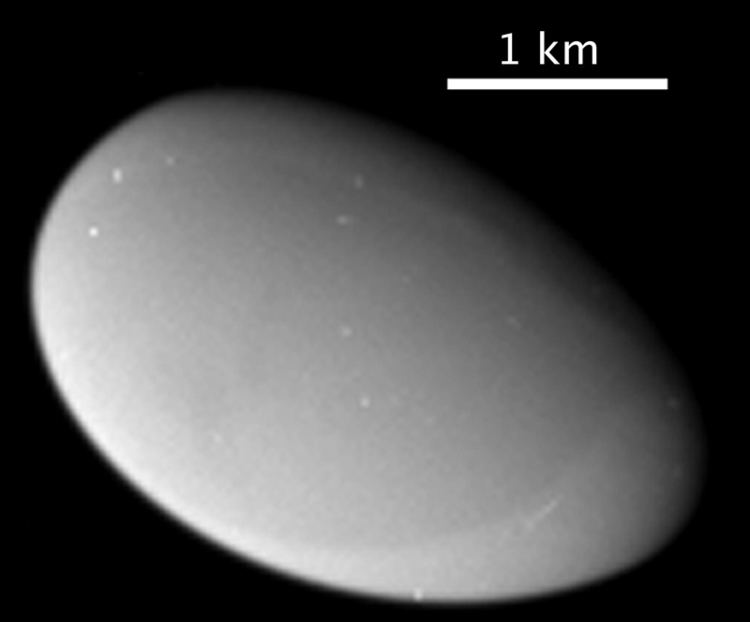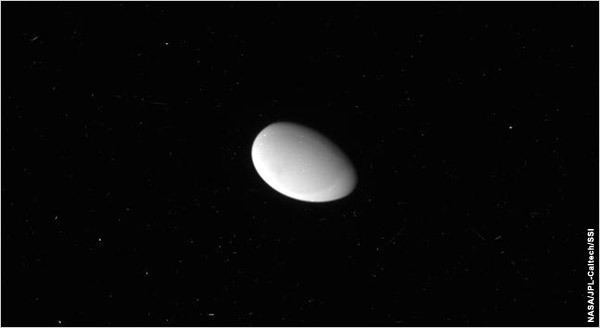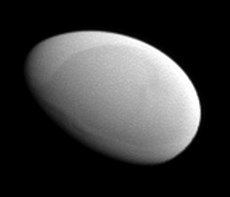Adjectives Methonean Discovered 1 June 2004 | Discovery date June 1, 2004 Orbital period 24 hours | |
 | ||
Pronunciation /mᵻˈθoʊniː/ mi-THOH-nee Semi-major axis 7008194440000000000♠194440±20 km Eccentricity 6996100000000000000♠0.0001 Similar Saturn moons, Other celestial objects | ||
Methone is a very small natural satellite of Saturn orbiting between the orbits of Mimas and Enceladus.
Contents
History

Methone was first seen by the Cassini Imaging Team and given the temporary designation S/2004 S 1. Methone is also named Saturn XXXII (32). The Cassini spacecraft has made two visits to Methone and its closest approach was made on May 20, 2012 with a minimum distance of 1,900 km (1,181 mi) from it.

The name Methone was approved by the IAU Working Group on Planetary System Nomenclature on January 21, 2005. It was ratified at the IAU General Assembly in 2006. Methone (Greek Μεθώνη) was one of the Alkyonides, the seven beautiful daughters of the Giant Alkyoneus.
Orbit

Methone's orbit is visibly affected by a perturbing 14:15 mean-longitude resonance with the much larger Mimas. This causes its osculating orbital elements to vary with an amplitude of about 20 km (12 mi) in semi-major axis, and 5° in longitude of its periapsis on a timescale of about 450 days. Its eccentricity also varies on different timescales between 0.0011 and 0.0037, and its inclination between about 0.003° and 0.020°.
Physical characteristics

In May 2012, the Cassini spacecraft obtained its first close-up photographs of Methone, revealing an egg-shaped moonlet with a remarkably smooth surface, with no visible craters. The moons Pallene and Aegaeon are thought to be similarly smooth. Methone has a two different sharply defined albedo regions, one distinctly (~13%) darker centered on Methone's leading point. It brighter area has an albedo of ~0.70. UV and IR spectra gave no indication of a color difference between the two regions, suggesting that a physical rather than compositional difference may be responsible. Increased exposure to electrons from Saturn's magnetosphere has been proposed to be responsible for thermal anomalies on the leading hemispheres of Mimas and Tethys, and a similar irradiation anisotropy might be behind Methone's albedo pattern.
Methone's mean radius is 7003145000000000000♠1.45±0.03 km.

Assuming that Methone is in hydrostatic equilibrium, i.e. that its elongated shape simply reflects the balance between the tidal force exerted by Saturn and Methone's gravity, its density can be estimated: 7002310000000000000♠0.31+0.05
−0.03 g/cm3, among the lowest density values obtained or inferred for a Solar System body. This indicates that Methone is composed of icy fluff, material that might be mobile enough to explain the lack of craters.
Relationship with Saturn's rings

Material blasted off Methone by micrometeoroid impacts is believed to the source of the Methone Ring Arc, a faint partial ring around Saturn co-orbital with Methone that was discovered in September 2006.
